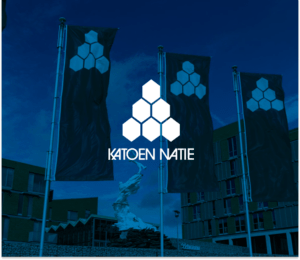Agile performance management is a hot topic. Any manager or HR leader worth their salt knows why:
Agile performance management sets the foundation for forging the apex organization that over 90% of executives aspire to build in today’s volatile marketplace:
The agile organization.
Such an organization – regardless of its size – acts as an objective, adaptive organism while enjoying the “mechanical” stability and strength of a traditional organization.
If you’re an HR leader or manager, however, transitioning from traditional to agile performance management is a bitter-sweet challenge. Embarking on this journey raises questions like:
- Where should you start with agile performance management?
- How should you implement agile performance management processes without destabilizing your existing systems and workflows?
- And what tools do you need to empower agile practices?
You’ll find answers in this post. I’ll share practical solutions and instructions to guide you through developing an agile performance management process.
(If you want to skip ahead to a specific topic, click on its title below.)
- What Is Agile Performance Management?
- Agile Performance Management Vs Traditional Performance Management
- The Powerful Benefits Of Agile Performance Management
- The Key Stages Of Agile Performance Management (With Examples)
- 7 Steps To Implement Agile Performance Management
- 5 Agile Performance Management Tools To Get You Started
- Moving From Traditional To Agile Performance Management
What Is Agile Performance Management?

Agile performance management is an approach to motivating employee performance, nurturing employee development, and aligning these two objectives under organizational and personal goals.
It focuses on frequent measurement, continuous performance feedback and incremental improvement throughout the year as opposed to annual or bi-annual appraisals and feedback cycles.
Once realistic Objectives and Key Results (OKRs) are established, the agile performance management process revolves around continuous check-ins – which often occur on a monthly or weekly basis.
Continuous communication is paramount because it cultivates meaningful relationships, opens up an ongoing dialogue between managers and staff, and draws attention to potential problems before they have a chance to harm productivity.
Therefore, an agile approach addresses the flaws and limitations inherent in traditional performance management. It does away with or limits the likelihood of vague, anxiety-inducing and biased performance management.
This gives you an approach that’s future-oriented, process-driven and primed to thrive in the thick of marketplace turmoil and disruptive change.
But what makes such an approach so much more effective for the modern enterprise?
Let’s take a look at the main differences between traditional performance management and agile performance management to find out.
Agile Performance Management Vs Traditional Performance Management
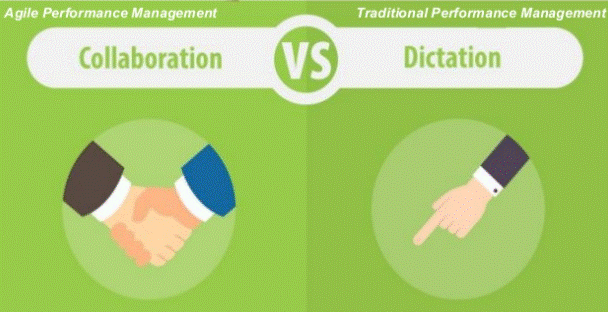
The differences between traditional and agile performance lie in origin, structure, methodology and practices.
Traditional performance management stems from Fredrick Taylor’s 20th-century talent management philosophy. It prioritizes efficient output on production lines and is characterized by top-down hierarchies, silos, and static performance management processes.
Agile performance management is a response to the modern dynamic marketplace that demands adaptability and alignment. Using frequent appraisals, check-ins and 360 feedback, it promotes efficiency by enabling flexibility, autonomy and ownership, all attributes desired in today’s world.
The tenets of traditional performance management don’t fare well in our fast-changing world:
- An appraisal at the start of the year aims to disseminate organizational goals, share expectations, communicate an employee’s past performance, and understand their career aspirations. This is often expressed in a personal employee development plan and documented using employee performance management software to detail employee objectives for the coming year. Squeezing all this into a single session is challenging. Quite often, it reduces the annual performance review into a “tick-the-box” exercise for managers and staff
- An end-of-year review. Rigid goals and objectives that are set at the start of the year and measured at the end leave no opportunity for course corrections and critical feedback.
- Feedback is provided long after an event occurs. Any improvement requires feedback that is timely and relevant. Retaining or “bottling up” feedback for presentation long after an event occurs is ineffective and generates anxiety for both the managers and staff.
An agile performance management process overcomes these flaws:
- Frequent check-ins give employees the feedback they crave.
- Two-way conversational check-ins promptly nudge employees in the right direction.
- Performance reviews no longer force managers/staff to endure annual appraisals that deliver “expired” feedback saved up from the start of the year to justify a rating.
The Powerful Benefits Of Agile Performance Management
The tangible benefits of agile performance management are transformational. Your organization stands to gain increased employee engagement, workforce productivity, profitability, and the enterprise agility needed to outmaneuver competitors. And best of all?
Most modern companies, managers and employees openly embrace an agile approach to management:
- Research by IBM’s Smarter Workforce Institute (SMW) shows that most employees “respond positively” to the flexibility and transparency of agile performance management.
- In the same IBM study, nearly 50% of employees reported that they “work more effectively” with an agile approach.
- Despite 65% percent of employees wanting more feedback, most don’t receive enough.
- 95% of managers are dissatisfied with their traditional performance management processes, venting that they are inaccurate for performance reviews.
The research paints a clear picture: agile performance management establishes an organizational North Star that keeps your workforce engaged, motivated and ready for change.
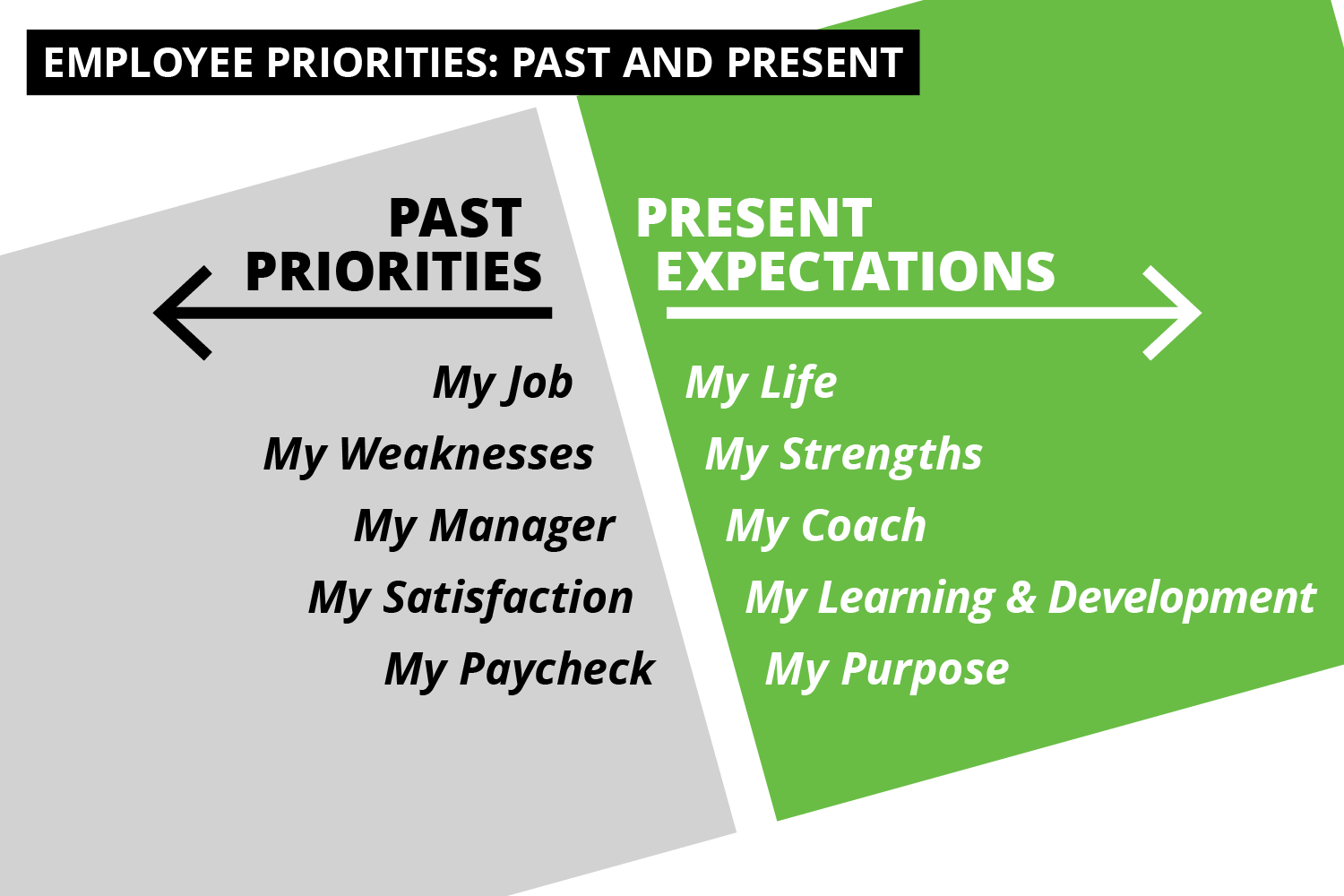
Implementing agile performance management (or continuous performance management), however, is a challenge for most organizations. Initiatives are prematurely thwarted because the adoption process is either non-existent, too drastic, or over-complicated and time-consuming.
In the next section, you’ll learn how to best approach the transition from a traditional to agile performance management system, and the foundational steps you need to build (or bolster) your company’s agile performance management process.
The Key Stages Of Agile Performance Management (With Examples)
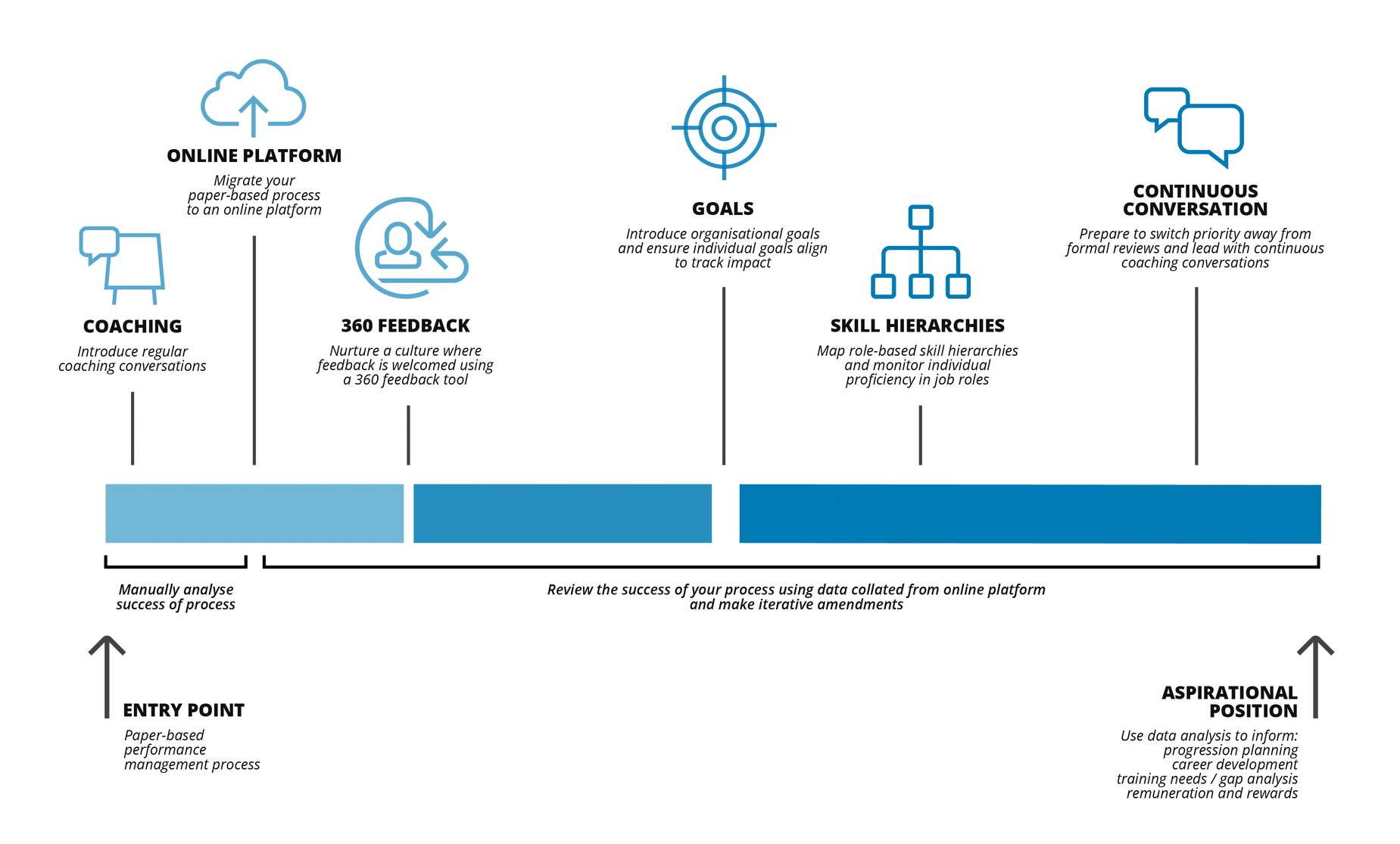
(As shown above: Totara Perform does not force you to adopt a specific approach. The system supports and grows with you, regardless of which end of the “performance management spectrum” you happen to sit on.)
Improvement is a deliberate, gradual process. Transitioning from traditional to agile performance management is no different.
Contrary to what some experts advocate, you don’t need to uproot your existing traditional performance management process (*shocked gasp*).
This is at best, unnecessary and inefficient, and at worst, damaging to the point of throwing your tenuous transition into disarray.
So, what’s the “safest” way for a risk-averse enterprise to deploy an agile performance management process?
1. Start slow. Speak to other decision-makers and key stakeholders holders involved. Compile the research (external and internal data) needed to make the case for influencing existing processes.
2. Gather internal research and feedback from within your organization. Ask the question: what are the simplest changes you can test for the best possible ROI on performance? (Hint: The typical answer is frequent check-ins and the use of goals.)
3. Experiment with a single unit or department within your organization.
4. Finally, measure the results of the changes you’ve made.
Adobe, the poster-company championed for abolishing performance reviews and catalyzing the adoption of agile performance check-ins, used this exact process to get started.
After gathering feedback from across the entire company and drafting multiple iterations to replace their onerous appraisal process, their newly-implemented continuous check-ins yielded significant growth in overall organizational performance.
Inspired by Adobe’s success, Accenture, a tech enterprise boasting over 300,000 employees at the time, also discontinued annual reviews and numeric ratings.
The company now follows an agile performance review system that prompts managers to provide feedback after assignments are completed.
To aid your transition from a traditional to agile approach, here’s a checklist overview listing the characteristics of a strong agile performance management process:
- The organization has a clear, shared vision that is understood by all employees.
- Goals are set using OKRs and regularly reviewed to ensure they align with corporate agendas.
- Automations (enabled by an agile performance management system) are in place. (Not to state the obvious, but a paper or document-based process will hinder efficiency.)
- Progression towards goals is easily tracked by managers and staff.
- Managers and staff are comfortable with exchanging feedback.
- The organization helps employees succeed in their current roles and towards potential roles within the business.
- The annual appraisal is now optional. But if used, it will be more effective because the manager can now draw on information gathered throughout the year.
7 Steps To Implement Agile Performance Management
When it comes to implementing an agile performance management process, it’s worth reiterating that practices and procedures are to be introduced gradually.
After reviewing your current approach to performance management, plan the immediate “wins” you can implement without destabilizing your current process or discombobulating your people.
Ranking the “process evolutions” with the best ROI and least disruptive potential, below are 7 steps to guide your transition from traditional to agile performance management:
1. Start With Agile Performance Management Tools
Moving to a more frequent, even continuous model of performance feedback requires embedding agile processes into your normal workflows.
This automatically changes perceptions, encourages more informal and multi-directional feedback, and makes conversations more meaningful. But using different tools to manually document:
- Feedback
- Check-in conversations
- OKRs
- Goals
- Competencies
And other parts of the management process creates chaotic workflows, paradoxically encumbering your performance management process instead of making it more “agile.”
Hence, it makes sense to start with an all-round agile performance management system that supports modern and traditional management, like Totara Perform.
2. Introduce Frequent Performance Check-ins
A check-in is a concise two-way conversation between managers and staff that’s often guided by a formal agenda. It usually focuses on either performance or development.
Frequent check-ins are pivotal to agile performance management because they consistently unlock opportunities to boost morale, trigger self-reflection or inspire immediate course correction.
Regular check-in conversations also lighten the overbearing pressure associated with annual reviews.
Schedule them monthly or weekly (account for the job role, the complexity of the tasks involved and the corporate culture you’re cultivating).
3. Establish Objectives And Key Results

OKRs provide a framework for realistically measuring and monitoring performance in a transparent – and when done right – motivating way.
Established OKRs act as a compass for every check-in and align the goals of your organization and its employees. They take time to get right, but the end result warrants the work you’ll put in:
You’ll know exactly how to track and reward performance. Across your desk (or screen), employees will know exactly which tasks to work towards, what success looks like and how their performance is measured.
Here’s more information on exactly what an OKR is and some OKR examples:
Objectives: Are the qualitative, broad and high-level outcomes that are to be achieved. Above all else, setting good objectives is about clarity. You should explicitly state what the objective is and the deadline for it.
Key Results: Quantify objectives and break them down into specific steps/stages that can be used to measure performance and track progress.
Example Objective:
Design and launch an internal learning and development system for your employees.
Example Key Result:
- Talk to 3 other HR Directors/CLOs on how they do internal training and development.
- Survey 15 team leaders on training needs and gaps.
- Draft 10 training modules.
4. Practice Continuous Feedback
Timely feedback is more impactful than feedback provided for month-old or expired events. It encourages instant behavioral change and keeps people focused on important goals.
Deploying a continuous feedback process (with your performance management system) also deepens the trust between managers and team members.
Team members will know what’s expected of them, where they are going wrong, and how good their performance is.
Equally, managers are more likely to self-identify as coaches and mentors rather than task-masters. This can stimulate a significant positive shift in your company’s corporate culture.
5. Progress To 360 Feedback
360 feedback is the “next stage” of continuous feedback. It describes the act of gathering input from everyone who engages or works with a reviewee. This can include:
- Team members
- Peers
- Direct reports
- Line managers
- Customers
- And suppliers
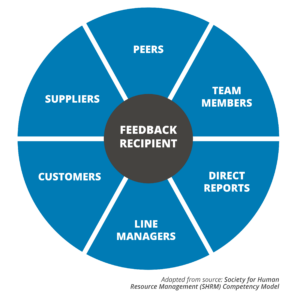
Once collected, 360 feedback can be delivered via an online system, or a check-in meeting.
Adopting 360 feedback benefits agile performance management because it mitigates bias. Feedback is supported (or compared against) input from an employee’s colleagues or customers, and is therefore more objective and accurate.
6. Use Competency Frameworks
Core competencies or specialist competencies (tailored to a specific role) are applicable across all job roles in an organization. They describe the knowledge and behaviors employees are expected to exhibit.
Often grouping job roles under job families, they also influence recruitment strategies and hiring decisions. Job families might include:
- Leadership
- Management and administration
- Product design and development
- Sales and marketing
- Technology and support
Within an agile performance management process, using both core and specialist competencies ensures consistency and equity in pay as well as providing a framework for career development.
7. Develop Your Workforce
Agile performance management makes it easier for managers and team members to recognize career development opportunities that will benefit individual and corporate goals.
The end result is a mutually beneficial system for all involved parties.
Once this skills-focused system is developed and automated, your organization is able to operate like an agile, intelligent and “self-healing” organism.
Threats that undermine your organization’s adaptability and competitiveness, like gaping skills or competency gaps, are quickly identified, diagnosed and dealt with.
If a specific group of competencies and skills are leaving you vulnerable to change, you can hire the expertise required or immediately assign training to the most relevant employees – who are probably already looking for that opportunity.
5 Agile Performance Management Tools To Get You Started
And that’s everything you need to know about getting started with agile performance management! As promised, here’s a list of tools to help you implement it:
Agile Performance Management Tool #1: Totara Perform

Totara Perform is an enterprise performance management system that empowers your transition from traditional to agile performance management.
It has both the power and flexibility to support the entire spectrum of performance management practices. From traditional annual appraisals to continuous performance check-ins, with Totara Perform you can:
- Set your own performance management schedules
- Organize recorded notes from check-in conversations
- Review competencies and skills gaps
- Gather 360 feedback
- And connect performance management KPIs to relevant learning goals
Agile Performance Management Tool #2: The Totara Talent Experience Platform
Totara’s Talent Experience Platform unlocks agile performance management and all the tools you need for modern employee experience management. It combines:
- Totara Learn – the flexible LMS used by millions of learners and favored by companies worldwide (such as Samsung and Indeed) to transform workplace learning.
- Totara Engage – the new Learning Experience Platform (LXP) that engages, unites and upskills your workforce through knowledge sharing with collaborative workspaces, learning playlists, Microsoft Teams integration and more.
- Totara Perform – the aforementioned agile performance management system that enables peak productivity and alignment for modern organizations.
This gives you an integrated, all-in-one platform that allows you to manage performance, upskill your workforce, and encourage collaboration and engagement.
Agile Performance Management Tool #3: Zoom
Remote work is here to stay.
50% of the US workforce will soon operate remotely, and most companies are already offering flexible working options, citing that they’ve seen an increase in both their profits and productivity as a result.
This makes tools like Zoom invaluable in your agile performance management arsenal, as an internet connection and Zoom subscription is all you need to conduct frequent check-ins and communicate with your entire team.
Agile Performance Management Tool #4: Mattermost
Collaboration/messaging tools such as Slack, Asana or Mattermost (our chosen tool at Totara) are game-changing for remote agile performance management.
They enable constant communication, group feedback and informal interactions that simulate virtual office and watercooler chats. This helps managers and staff maintain healthy working relationships.
Agile Performance Management Tool #5: Viamaven
Writing performance reviews can be time-consuming. Fortunately, performance review feedback generators can expedite the process.
Created by HR and linguistic experts, ViaMaven suggests curated feedback phrases across many categories including attention to detail, teamwork and communication skills.
Viamaven is recommended (Totara has no commercial affiliation with them) because the tool provides realistic and real-world performance review phrases; you avoid the shame of sounding like an algorithm wrote your performance review.
Moving From Traditional To Agile Performance Management
If you’re yet to move from traditional performance management to agile performance management, keep the following tips in mind:
- Start slow and consult other decision-makers. If necessary, secure buy-in from senior stakeholders with research that explains the benefits of becoming more “agile.” (And don’t forget to share this article!)
- Research and gather feedback from your teams to determine which new performance management practices you should prioritize. (Introducing frequent check-ins and OKRs is often a good start. )
- Experiment. Roll out changes to a single unit within your organization and measure the results. Feel free to test different iterations of your agile performance management process – like experimenting with monthly vs weekly performance check-ins.
- Use supportive performance management technology. Totara Perform, for example, supports both traditional and agile performance management. It also connects with your existing HCM and CRM tools to help you make the switch without destabilizing existing processes and workflows.


